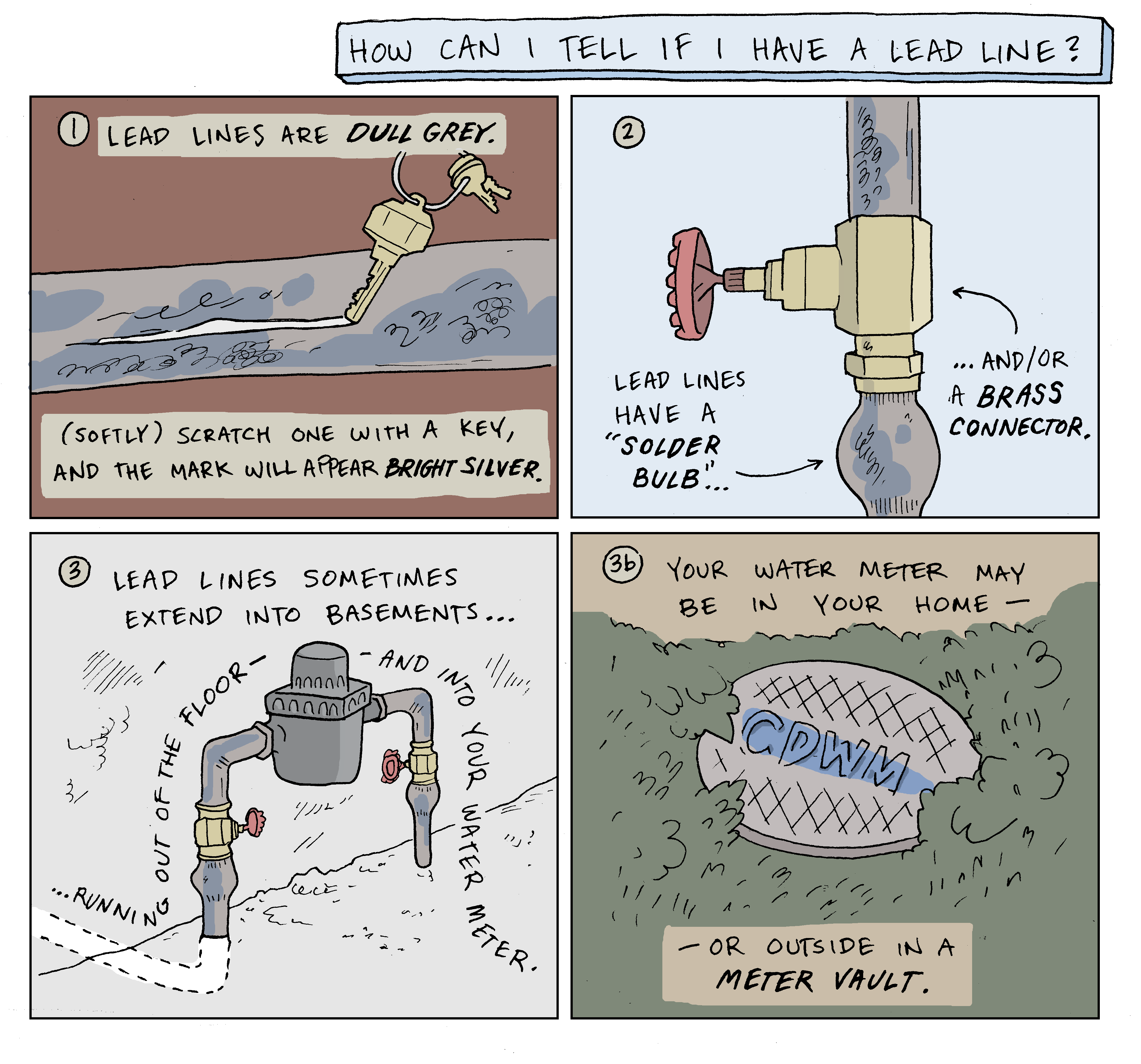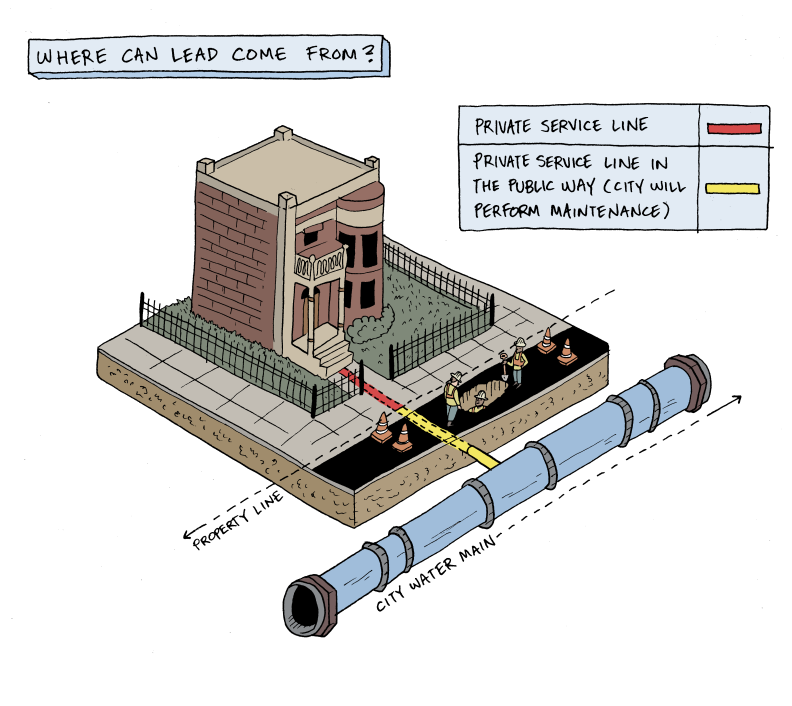Wearing glasses and a heavy green sweater, Patrick MacRoy kneels down in the sweltering basement of his yellow brick Andersonville condominium and presses a key against the metal pipe. As he begins scratching it, silver filings shave off the pipe and fall onto the floor. That’s how MacRoy, the former director of the city’s Lead Poison Prevention Program, knows that the pipe (known as a service line) that brings drinking water from the city’s water main into his twenty-four-unit building is made out of lead, a toxic metal long known to cause cognitive and physical impairments in children.
Experts say Chicago has more lead service lines than any other American city, yet MacRoy never thought to check his own service line because of the size of his building. Larger buildings require bigger pipes, and lead is a soft metal typically used for narrower lines. Then his condo association installed a sprinkler system in the courtyard, and MacRoy spotted a note that the plumber had written on his estimate: “Water main – 2 inch lead.”
“I looked at that and went, ‘Really?’” MacRoy says. He ordered a water testing kit from the city, but it did not detect elevated lead levels. Still, MacRoy wasn’t convinced, since he knows all too well that contaminated pipes sometimes have clean water readings.
“If the pipe is disturbed, whether through construction or some sort of shaking, it releases particles of lead that come through in an unpredictable way,” he says.


In fact, national evidence is mounting that the chemical treatment of lead pipes—a common method used by cities like Chicago—is inadequate to keep the toxin out of drinking water, particularly when there is any street disturbance due to construction, large trucks on the road, or even changes in temperature. Yet as other cities such as Milwaukee and Cincinnati begin to address the problem by systematically replacing their lead service lines, and the Environmental Protection Agency considers requiring cities to do so, Chicago is leaving residents and property owners to deal with the problem. In fact, the city is in the middle of ramping up its 900-mile water main infrastructure project without taking inventory of lead service lines and with no plan to replace them.
Service lines are the pipes that connect iron water mains running under the streets into buildings to provide drinking and cooking water. To prevent lead from leaching directly into the water, the pipes are chemically treated with orthophosphate, which coats the lead pipes and prevents corrosion. This coating comes off when the pipes are disturbed. Without that protective orthophosphate coating, water can quickly become contaminated by lead—as it did in Flint, MI, where one sample had astronomical lead levels of 13,200 parts per billion, and tens of thousands of children were exposed to the poisonous substance.
In Chicago the use of lead in pipes was required by plumbing codes until Congress banned it in 1986, despite the fact that most major cities stopped using it in the 1950s. Estimates show that eighty percent of Chicago’s properties have a lead pipe, an unusually high number that prompted Tom Neltner, chemicals policy director at the Environmental Defense Fund, to call the city “ground zero for lead service lines.”
To compound the problem, in Chicago, the entirety of the service line stretching from the public water main to the home is considered private property. (Elsewhere, lead service lines are owned partially by the water utility and partially by property owners.) That’s why the city claims it is not taking action to inventory or replace any lead service lines—it doesn’t own them. The city will only perform spot repairs when there is a leak in a service line that’s in the public way, according to Gary Litherland, a spokesman for the Department of Water Management, “because it’s in the public way [and] we feel the responsibility to the public to keep that public way safe.”
But experts on lead say that as a matter of public health, the city should take action. They argue that the most cost-effective way of dealing with the lead pipe problem in Chicago is to replace them when the city opens the street to replace water mains. Since the pipes would be exposed, residents would not need to do any additional digging to reach the pipes. In places like Milwaukee and Green Bay, WI, the city is sharing the replacement cost with homeowners. Other towns have applied for federal funding—just this weekend, the U.S. Senate passed a bill that would provide $170 million to Flint to replace its 29,000 lead service lines. Some began their pipe replacement programs as early as the 1950s.

Since 2009, Chicago has conducted more than 1,600 water main and sewer replacement projects, a necessity given that many of the city’s water mains are more than one hundred years old. Not only is each project an opportunity to take stock of the lead hazard underground, but the construction could agitate the connected service lines and cause lead to leach into the drinking water.
MacRoy says he thinks it’s a “disservice, from a public health standpoint,” for public officials to not take action to fix lead service lines. “For the city to just kind of wash their hands of it and say, ‘Oh well, it’s the property owner’s responsibility,’ denies the fact that they were the ones who mandated this connection, particularly so long after everyone else stopped,” he says.
Recently, Humboldt Park and West Ridge residents joined together in a class-action lawsuit contending that city officials knew about the risk of toxic lead levels entering tap water from construction projects and did not adequately warn residents or do anything to mitigate the problem. The lawsuit seeks to have the city pay to replace all lead service lines with copper and to establish a trust fund to pay for lead-related medical monitoring. In October, a judge granted the city’s motion to dismiss the suit without prejudice, but the plaintiffs say they will re-submit the case next month.
Meanwhile, the Department of Water Management announced in August that it would conduct a study to determine the possible impacts of water main construction on water quality for homes with lead service lines.
It’s a move that Mark Vazquez, an attorney representing the residents in the class action suit, says, “is focused on disproving the conclusion that water quality experts have come to around the country … Now is the time to be focusing on a solution. And it seems like the city is still intent on determining whether or not there is a problem.”
This story was produced in partnership with City Bureau, a Chicago-based journalism lab.
Did you like this article? Support local journalism by donating to South Side Weekly today.


Thank you for this enlightening piece. Safe drinking water should be a fundamental focus of any city’s governance.
Thanks for the article. Home inspector here. A third test homeowners can do to determine material is to place a magnet on their service pipe, since lead is non-magnetic. Residents of rehabbed properties should be aware that less-than-scrupulous “flippers” may try to hide lead service pipe behind drywall, or even by placing a piece of sleeve pipe around it. If the pipe coming in has rust on it, the latter could be the case, as it is rare for a building with less than 6 units to have steel service pipe. You may have to dig out a bit of concrete around it to get to the real pipe.
If you cannot afford to have your service pipe replaced or need time to save money, you can install water filters for drinking and cooking to keep your family safe in the interim. Under-sink models start at around $200, and many can be installed without hiring a plumber. Whole-house filters usually require a plumber to install, and can easily run over $1,000 with labor. Make sure to check that water line filters for your refrigerator dispenser/ice maker remove lead. If not, the manufacturer may have replacements available that do.
Looking for options for our Cleveland Ohio folks living in Lead.